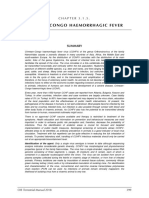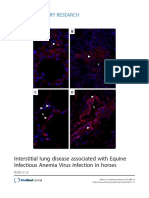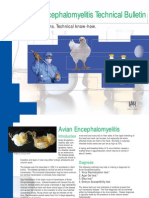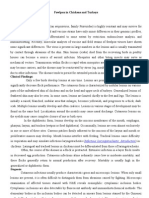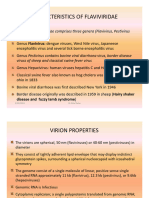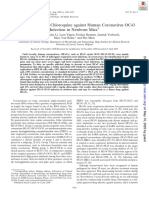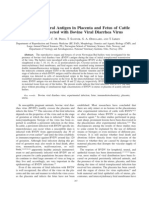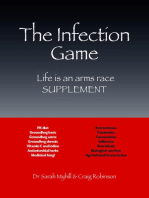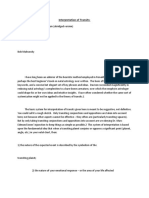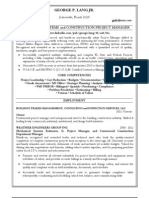0 ratings0% found this document useful (0 votes)
226 viewsEquine Coital Exanthema
Equine Coital Exanthema
Uploaded by
Imran KhanThis document summarizes equine coital exanthema, a venereally transmitted disease of horses caused by the herpesvirus EHV-3. It is characterized by superficial pock-like eruptions and erosions or ulcers on the external genital organs of mares and stallions. While the infection does not typically cause systemic illness or infertility, it can force temporary disruptions to breeding activities. The virus is transmitted through direct skin-to-skin contact during mating and has an incubation period of 5-9 days. Recovery is usually complete within 2-3 weeks without lasting effects.
Copyright:
© All Rights Reserved
Available Formats
Download as PDF, TXT or read online from Scribd
Equine Coital Exanthema
Equine Coital Exanthema
Uploaded by
Imran Khan0 ratings0% found this document useful (0 votes)
226 views8 pagesThis document summarizes equine coital exanthema, a venereally transmitted disease of horses caused by the herpesvirus EHV-3. It is characterized by superficial pock-like eruptions and erosions or ulcers on the external genital organs of mares and stallions. While the infection does not typically cause systemic illness or infertility, it can force temporary disruptions to breeding activities. The virus is transmitted through direct skin-to-skin contact during mating and has an incubation period of 5-9 days. Recovery is usually complete within 2-3 weeks without lasting effects.
Original Description:
Equine Coital Exanthema
Copyright
© © All Rights Reserved
Available Formats
PDF, TXT or read online from Scribd
Share this document
Did you find this document useful?
Is this content inappropriate?
This document summarizes equine coital exanthema, a venereally transmitted disease of horses caused by the herpesvirus EHV-3. It is characterized by superficial pock-like eruptions and erosions or ulcers on the external genital organs of mares and stallions. While the infection does not typically cause systemic illness or infertility, it can force temporary disruptions to breeding activities. The virus is transmitted through direct skin-to-skin contact during mating and has an incubation period of 5-9 days. Recovery is usually complete within 2-3 weeks without lasting effects.
Copyright:
© All Rights Reserved
Available Formats
Download as PDF, TXT or read online from Scribd
Download as pdf or txt
0 ratings0% found this document useful (0 votes)
226 views8 pagesEquine Coital Exanthema
Equine Coital Exanthema
Uploaded by
Imran KhanThis document summarizes equine coital exanthema, a venereally transmitted disease of horses caused by the herpesvirus EHV-3. It is characterized by superficial pock-like eruptions and erosions or ulcers on the external genital organs of mares and stallions. While the infection does not typically cause systemic illness or infertility, it can force temporary disruptions to breeding activities. The virus is transmitted through direct skin-to-skin contact during mating and has an incubation period of 5-9 days. Recovery is usually complete within 2-3 weeks without lasting effects.
Copyright:
© All Rights Reserved
Available Formats
Download as PDF, TXT or read online from Scribd
Download as pdf or txt
You are on page 1of 8
78
Equine coital exanthema
Synonyms: Genital horse pox, eruptive venereal disease, equine
venereal vulvitis or balanitis, and coital vesicular exanthema
G.P. ALLEN AND N.W. UMPHENOUR
INTRODUCTION
Equine coital exanthema (ECE) is an infectious, venereally
transmitted mucocutaneous disease of mares and stallions
caused by a herpesvirus. The disease is characterised by the
development of superficial pock-like eruptions and erosions or
ulcers on the external genital organs.8, 15, 20, 51 The virus is
highly contagious but is noninvasive and relatively benign.
Reports of the disease have long been recorded in the
veterinary literature under a variety of names.7, 11, 16, 19, 32, 34, 39,
41, 43, 44
The infection does not usually result in systemic illness,
and neither infertility nor abortion occur as sequelae.12, 20, 24, 36,
38, 51
Its primary negative impact on equine breeding
enterprises is the forced, temporary disruption of mating
activities. In intensively managed stud operations employing
heavily-scheduled breeding dates for stallions, such
disruptions may translate into significant end-of-season
decreases in the mare-book size of affected stallions.
Similarly, delayed foaling dates or reduced pregnancy rates
may occur in mares that miss breeding opportunities because
of the disease.
AETIOLOGY
The causative agent of ECE, Equid herpesvirus 3 (EHV-3), is
a member of the Herpesviridae family and in size, virion
architecture, and genome structure is a typical herpesvirus.4, 12,
29, 35, 46
Its biological features place EHV-3 in the
Alphaherpesvirinae subfamily. Equid herpesvirus 3 is
antigenically, genetically, and pathogenetically distinct from
Equid herpesvirus 1 (EHV-1), EHV-2, EHV-4, and EHV-5.2, 6,
12, 26, 45
It shares no protective or neutralisation epitopes and
only minor genetic homology with these four other
herpesviruses of the domestic horse (Equus caballus). 2, 45, 53
The restriction endonuclease cleavage patterns of the DNA of
EHV-3 are unique when compared with those reported for the
DNAs from EHV-1, EHV-2, EHV-4, and EHV-5.9, 29, 31, 46
Although causing disease of clinical similarity, the virus of
ECE is unrelated, by serum neutralization tests, to bovine
herpesvirus 1 (BHV-1) that causes infectious pustular
vulvovaginitis in cattle.12
The 96 Md double-stranded DNA of EHV-3 is high in G +
C content (66 per cent) and has a buoyant density of 1,725
g/cm3.35 Purified virions of EHV-3 possess, in addition to the
DNA-containing nucleocapsid, a proteinaceous tegument and
glycoprotein-laden envelope.3 The virus is environmentally
labile, and infectivity is quickly destroyed by lipid solvents,
detergents, heat, and drying as well as by the common
disinfectants available for veterinary use.12 Storage at
temperatures below -60 C is required for maintaining its
long-term viability.
In cell culture, EHV-3 replicates only in cell lines derived
from equids.12 The intracellular replication cycle and
subsequent cytopathic effect (CPE) are extremely rapid. Equid
herpesvirus 3 progeny DNA and virions are present by two
and six hours post-infection (PI), respectively, and CPE is
detectable as early as 6 hours PI after a high multiplicity of
infection.1 The CPE of EHV-3 is typically herpetic in nature
with rapidly enlarging foci of rounded, refractile cells. When
infected cell cultures are stained with haematoxylin and eosin,
eosinophilic, intranuclear inclusion bodies are visible.22, 40 The
optimal temperature for in vitro replication of EHV-3 is 34 C;
at 39 C, the production of infectious virus is reduced to 10-6
of its maximum yield.9, 27, 30 No laboratory animal model of
EHV-3 infection has been identified.
Although restriction endonuclease fingerprint analysis of
viral DNAs has been used to demonstrate the genetic
individuality of EHV-3 isolates,9 there is no reported evidence
of antigenic diversity among clinical isolates recovered from
different disease outbreaks.12 A related but antigenically
distinguishable herpesvirus (Equid herpesvirus 6) has been
isolated from superficial cutaneous lesions of a donkey.12, 28
Small-plaque variants of EHV-3 arise during passage in cell
culture and are characterized by alterations in their DNA
restriction endonuclease patterns caused by the presence of a
5,7 kbp nucleic acid insert in the unique (U) sequence of the
small (S) component of their DNA genomes.9, 12, 31
EPIDEMIOLOGY
The only known biological reservoir for the virus of ECE is
the latently infected horse. Careful observations and frequent
serological monitoring of a closed, pony-breeding herd has
demonstrated the existence of latently infected carrier animals
from which EHV-3 was periodically reactivated and
transmitted to cohorts.14 By serological tests, it was shown that
some pony stallions and mares acquired primary infection or
reinfection by EHV-3 without signs of clinical disease. It is
now believed that such episodes of virus reactivation from
latency with subsequent recrudescence of clinical (or
subclinical) infection serve as the source for spread of EHV-3
to other animals.7, 14, 16, 24 Epidemiological data suggest that the
original viral source of an outbreak of ECE may be either a
visiting mare brought onto the stud farm for breeding or virus
reactivated from a member of the resident stallion or mare
population.7, 14, 16, 24 Persistently infected horses that shed
EHV-3 continuously have not been identified. The anatomical
site that harbours the latent herpesvirus is unknown.
Surveys to estimate the seroprevalence of EHV-3 infection
in several horse populations have demonstrated the existence
of EHV-3 specific antibodies in 18 per cent to 53 per cent of
horses of breeding age.5, 37, 47 Maternally derived antibody to
EHV-3 is present in new-born foals but decays to undetectable
levels by four months of age.37 The seroprevalence of
infection is low in young and in unmated horses, but increases
slowly with age in breeding animals.5, 37
Clinically apparent ECE occurs only sporadically in most
breeding establishments. Its overall incidence is unknown.
Once recrudescence of EHV-3 infection has occurred, ECE is
highly contagious; postcoital infection rates as high as 100 per
cent have been reported.7, 22 The primary method of virus
transmission is through direct skin-to-skin contact by coitus
with an actively infected, virus-shedding horse. The
incubation period is five to nine days. Experimental
transmission of ECE from infected mares to stallions by coitus
has been demonstrated.25, 37 Evidence exists to indicate that
subclinically infected horses without visibly noticeable lesions
can also transmit the virus to their breeding partners.14 The
potential for virus spread during artificial insemination has not
been explored. Iatrogenic transmission of infection can occur
by virus-contaminated objects, such as buckets, instruments,
tools and examination sleeves, used for the purposes of
breeding, grooming, rectal palpation, or gynaecological
examination.8, 15 Reports of ECE lesions on the lips and
nostrils of some horses indicate that noncoital transmission of
infection by the genito-nasal contact associated with
behavioural nuzzling/sniffing may be possible.13, 16, 17, 33 The
likelihood of mechanical transmission by stable flies has also
been suggested.24
Because ECE is endemic in most horse breeding areas,5, 7,
23, 24, 33, 41, 50
there are at present no international restrictions on
the export/import of horses from countries or from horse
populations in which ECE is known to occur.
PATHOGENESIS
Infection by EHV-3 occurs via direct cutaneous contact either
during the act of coitus or by the transfer of virus-containing
secretions from contaminated objects, such as hands, gloves,
instruments, palpation sleeves, sponges and the lips or nose of
a horse. The virus is easily transmitted by simple contact with
the skin; the epidermal surface need not be damaged for
infection to be established.12, 33, 38, 53
Viral replication is limited to the stratified epithelium of
epidermal tissue present within the skin or at mucocutaneous
margins. Destruction of epithelium by the lytic virus infection
elicits a vigorous, localised inflammatory response that gives
rise to the formation of the characteristic cutaneous lesions of
ECE. Viral invasion of tissue within blood vessels or the
stroma of the dermis underlying the epithelial lesion does not
occur, and systemic dissemination of EHV-3 has not been
reported. Secondary bacterial infection with Streptococcus
equi zooepidemicus is common and influences the character,
severity, and duration of the epithelial lesions. Recovery from
ECE is complete in a matter of two to three weeks and occurs
without permanent sequelae.
The horse responds to infection by EHV-3 with the
production of serum complement-fixing (CF) and virusneutralising (VN) antibodies that reach maximal levels 14 to
21 days after infection.12, 14, 37, 38, 53 In comparison to the equine
humoral immune response mounted against the systemically
infecting herpesviruses of the horse, peak antibody titres
against EHV-3 are relatively low.7, 12, 25, 38 Complement
fixation titres decline rapidly after infection (six to eight
weeks), whereas VN activity declines more slowly with
detectable levels persisting for a year or more.37 Post-exposure
immunity to reinfection by EHV-3 is short-lived, and both
stallions and mares have been observed to develop the disease
in consecutive breeding seasons.49, 50
CLINICAL SIGNS
The clinical presentation of equine coital exanthema is
characterized by the presence of superficial lesions on the skin
of the external genitalia of mares or stallions (Figures 78.1
and 78.2). The progress of each cutaneous lesion follows a
well-defined and predictable course.7, 8, 10, 11, 12, 15, 19, 20, 24, 25, 37,
39, 40, 41, 42, 43, 44, 51
Appearing initially as a small (13 mm)
raised papule which often goes unnoticed, the lesion then
progresses sequentially to a vesicle, a pustule, and, after
epidermal sloughing of the necrotic dome of the pustule, to a
shallow, raw or encrusted erosion or ulcer. The progression to
fully developed lesions is rapid, occurring over the period of
only a few days. Initially, the individual erosions and ulcers
are discrete and uniform in size (5 to 10 mm) and distinctly
pock-like with raised borders and sunken centres. As they
develop in size, however, the lesions may coalesce to form
extensive epidermal erosions or ulcers. Localised
inflammation is invariably present and gives rise to tissue
congestion and erythema as well as, in the mare, oedema of
the vulvar labia, perineum and inner thighs. In the stallion,
oedema of the prepuce and sheath may occur and extend
laterally onto the ventral abdominal wall and scrotum. Lesions
infected secondarily with bacteria may exude a whitish
discharge. The lesions may be few or many in number and
may be at different clinical stages. Both the severity and
duration of the disease varies considerably among individual
FIGURE 78.1
Equine coital exanthema in the mare, showing lesions present on the external cutaneous
surface or on the internal mucosal surface of the vulvar labia. A sequential progression of
the clinical stages of ECE lesions, from vesicular to pustular to ulcerative and then to
healed white scars, is illustrated in panels A to D. The photographs in panels A and B
were reproduced from reference #24 with permission of the publisher.
FIGURE 78.2
Lesions of equine coital exanthema on the shaft of the penis of stallions (panels A, B, and
C) and on the perineal skin of a mare (panel D)
horses. In uncomplicated cases, healing of the lesions of ECE
is complete by 10 to 14 days, but their locations may be
marked by depigmented cutaneous scars that persist for many
weeks. The healing process is prolonged by centrifugal spread
of infection and the appearance of new lesions during the
course of the disease.
The in vivo replication of EHV-3 in the horse is restricted
to anatomical sites covered by true cutaneous (stratified
squamous) epithelium or by the transitional epithelium at the
mucocutaneous junctions of the nares, urethral orifice, and
female genital vestibule. Whether this represents a genuine
tissue tropism or merely reflects the demonstrated
temperature-sensitive nature of the virus is unsettled.9, 27, 30
Because of this anatomical restriction, the lesions of ECE are
most commonly located on the external (cutaneous) surface of
the vulva and surrounding perineal skin in the mare, and, in
the stallion, on the glans and free body of the penis as well as
on both the parietal and visceral folds of the prepuce. In
mares, lesions commonly extend beyond the mucodermal
junction of the vulva and may be present on its inner,
nonpigmented mucosal surface as well as on the clitoris, fossa
clitoridis, or the walls of the vaginal vestibule. On rare
occasions, EHV-3 lesions have been noted also on the skin of
the ventral surface of the tail, buttocks, medial aspect of the
thighs, or abdomen adjacent to the genital areas 24, 40, 50 as well
as at extragenital epidermal sites on the muzzle, lips, or
nostrils.17,33
Experimental inoculation of EHV-3 into young horses by
the intranasal route resulted in ulcerations of the nasal mucosa
with accompanying pyrexia and nasal discharge.12, 13, 53 Unlike
coital exanthema of cattle, lesions within the cranial vaginal
canal of the mare are not a prominent feature of EHV-3
infection.
Systemic signs of infection (e.g. fever, anorexia, or
dullness) in ECE is the exception, but vulvar discharge, tail
switching, frequent urination, or arching of the back have been
reported in severely affected mares.34 Occasionally, stallions
with extensive ECE lesions exhibit a stiff gait, pyrexia,
inappetence and are so debilitated with discomfort from the
disease that they lose libido and refuse to mount and copulate
with mares.40 The disease is not known to cause any long-term
impairment of fertility in either mares or stallions.8, 36, 37
Abortions caused by natural EHV-3 infection of the foetus
have not been reported.
Horses with chronically recurrent ECE in which lesions
recrudesce annually during the terminal period of pregnancy
or after foaling have been observed, most commonly in aged
broodmares.11
PATHOLOGY
Detailed histopathological examination of exanthemous ECE
lesions through the course of their development remains to be
conducted.
Necrotic epithelium covering the erosions or ulcers is
sloughed and replaced by a fibrin exudate in which are trapped
polymorphonuclear and mononuclear leukocytes. The
underlying dermis is oedematous and heavily infiltrated with
inflammatory cells. The transition from necrotic tissue to
normal epithelium at the edges of the erosions/ulcers is
sharply defined. Typical herpesvirus intranuclear inclusion
bodies are usually present in some epithelial cells at the border
of the erosions.
DIAGNOSIS
The genital lesions of ECE in both mares and stallions are
usually characteristic enough in their appearance for a clinical
diagnosis to be made with reasonable certainty. If necessary, a
presumptive diagnosis can be confirmed in the laboratory by
polymerase chain reaction (PCR), by isolation of the virus or
by demonstration of either seroconversion or a four-fold or
greater rise in antibody titre in paired serum samples.
Important specimens to be submitted for laboratory
confirmation of ECE are (1) clinical material collected from
the edges of fresh, active lesions by firm swabbing or
scraping, and (2) two clotted blood samples without
anticoagulant, one taken during the acute illness and the other
three to four weeks later. Specimens for virus isolation should
be submitted in 23 ml of tissue culture medium (containing
antibiotics and antimycotics) on ice to a competent laboratory.
Isolation of EHV-3 requires inoculation of equine-derived
cell cultures; e.g. equine dermal (E-Derm), foetal equine
kidney (FEK), or equine embryonic lung (EEL) cells.
Increased success of virus isolation is achieved if material
collected from cutaneous erosions is inoculated directly (i.e.
without prior homogenization, centrifugation, or filtration)
onto monolayers of susceptible cells. Greater than the usual
concentrations of antibiotics and antimycotics may be
necessary to control bacterial and/or fungal contamination in
such inoculated cell cultures. Cytopathic effect by EHV-3 is
generally evident by one to two days after inoculation of cell
monolayers.
Definitive identification of virus isolated in cell culture is
best achieved by performing infectivity-neutralisation tests
with EHV-3 reference antiserum.22 Techniques to detect EHV3 in inoculated cell cultures or in clinical material by PCR
have been described, 21 but immunohistochemistry assays
have not yet been routinely applied. Because the
immunofluorescence test for EHV-3 has been reported to
cross-react with EHV-1, it should be used with caution.26
A serological diagnosis of recent infection with EHV-3
can sometimes be made, retrospectively, by the demonstration
of a significant rise in the level of neutralising antibody
between acute and convalescent serum samples. Because the
equine antibody response to infection with EHV-3 may be
minimal, a failure to demonstrate the conventionally required
four-fold rise in antibody titre may occur and should not
necessarily be interpreted as evidence for the absence of
infection.24 Detection of serum CF antibody to EHV-3 has
been reported to be indicative of viral infection within the
previous 60 days.38
DIFFERENTIAL DIAGNOSIS
Clinically typical cases of ECE can usually be diagnosed in
the field without difficulty. In ECE-like outbreaks
accompanied by exanthemous lesions on the lips or nostrils of
horses, vesicular stomatitis must be considered. In
geographical areas where true horse pox still occurs, this
orthopox virus disease should be included in the differential
diagnosis. Contagious equine metritis (caused by Taylorella
equigenitalis) should be excluded by careful laboratory
examination in mares in which a mucopurulent vulvar
discharge is a prominent feature of the clinical picture. It
should be borne in mind that exanthemous lesions on the
external genitalia of mares as a result of infection with equid
herpesvirus 1 have, on occasion, been reported.12, 41, 48, 52
CONTROL AND TREATMENT
A commercial vaccine against ECE has not been developed.
Because of the existence of latently infected carrier animals in
most horse populations, occasional reactivations of latent virus
with recrudescence of clinical or subclinical infections with
EHV-3 are unavoidable. As reactivation of latent virus is not
preventable, the basis for controlling the impact of outbreaks
of ECE in breeding establishments is containment of the
spread of infection.
A stringent code of practice should be implemented within
breeding sheds following observation of a case of ECE. The
three priorities necessary for successful ECE control are:
cessation of breeding of clinically affected animals;
heightened vigilance on the part of personnel for early
recognition of new clinical cases; and,
strict adherence to breeding shed hygiene procedures
designed to eliminate mechanical transmission of the
virus.
The most effective method for restricting the transmission of
Finally, all instruments, buckets, and assist devices used
during the breeding procedure should be washed and sterilized
between use or fitted with clean disposable covers or liners.
The therapeutic objective of the treatment of breeding
stallions and mares exhibiting ECE is shortening of the
required period of suspended mating by promoting the rapid
and uncomplicated healing of genital lesions. Treatment
usually consists of daily cleansing of the genitalia, reducing
any inflammation, and preventing secondary bacterial
infection. Therapy is thus palliative and prophylactic rather
than curative. Three functional categories of medicinals form
the basis for most reported treatment regimens: antimicrobials
for control of secondary bacterial infection of the lesions;
antiseptics/stringents for cleansing and drying of the lesions;
and, glucocorticosteroid anti-inflammatory agents. All are
applied topically, once or twice daily, as creme- or ointmentbased emollients. During cleansing or topical application of
medicinals, care should be taken to avoid accidental, traumatic
removal of the crusts of healing sores. Although effective in
reducing inflammation, corticosteroids may slow the healing
process. Representative treatment regimens have included
topically applied mixtures of (1) nitrofurazone, neomycin,
prednisolone creme;36 (2) oxytetracycline, polymixin B
opthalmic ointment;36 (3) chlorohexidine creme and
dimethylsulfoxide mixture;22 (4) nitrofurazone, silver
sulfadiazine creme,49 and (5) sodium propionate, gentian
violet, acriflavine mixture.49 Acceleration of the healing
process by laser treatment of the lesions, in conjunction with
vitamin E ointment, has also been explored.49 In severely
affected animals exhibiting pyrexia and/or anorexia,
systemically administered antibiotics have been included in
the treatment regimens. 22, 40
Though theoretically promising as a treatment modality,
the topical use of the antiviral compound, acyclovir, for
facilitating the healing of ECE lesions has not been fully
explored. A 5% topical, creme formulation of acyclovir
marketed for use in the treatment of herpetic skin lesions in
people has recently been used in the treatment of coital
exanthema in both stallions and mares. 18
EHV-3 infection remains the immediate cessation of mating
activities of clinically affected stallions and mares. The
decision to return an EHV-3 infected stallion or mare to
breeding service should be based on a clinical evaluation of
whether the genital lesions are still infective rather than on a
prescribed length of time. Lesions should be fully granulated
and regressed to a point that the likelihood of virus still being
shed is low. The quarantine time interval, which may vary
from horse to horse, will be influenced by the extent and
severity of the lesions and by the rapidity of the healing
process. The recovery period may be prolonged by secondary
bacterial infection. For stallions, this period of breeding
inactivity may, with appropriate management, be reduced to as
little as seven days.49
Personnel assisting with the preparation of mares or
stallions for breeding should be informed of the importance of
early detection of new cases of ECE and trained in recognition
of the lesions characteristic of the disease. Assistants in the
mare chute area responsible for preparing mares for cover (e.g.
washing the genitalia and wrapping the tail) can be
instrumental in identifying animals with suspect lesions.
Similarly, stallion crew members working close to the animals
during mating often have the best vantage point for
recognition of a new case of ECE.
Strict adherence to hygienic measures designed for
preventing the mechanical spread of EHV-3 during an ECE
outbreak is a critical component of the disease control plan.
Care must be taken to avoid iatrogenic transmission of the
virus through contaminated equipment such as rectal sleeves,
vaginal specula, insemination utensils, etc. Breeding shed
personnel who have direct contact with horses should wear
long, disposable examination sleeves and short latex gloves
which are changed between each horse handled. Mare
preparation chutes should be washed down with water and
then disinfected between the preparation of each mare to
prevent cross-infection. A thorough rinsing of each stallion's
penis and prepuce with plain warm water after each mating
has been used with the aim of reducing the virus load of any
potential inoculum of EHV-3 acquired from the covered mare.
REFERENCES
1
ALLEN, G.P. & BRYANS, J.T., 1977. Replication of
equine herpesvirus type 3: kinetics of infectious
particle formation and virus nucleic acid synthesis.
Journal of General Virology, 34, 421430.
ALLEN, G.P., O'CALLAGHAN, D.J. & RANDALL,
C.C., 1977. Genetic relatedness of equine herpesvirus
types 1 and 3. Journal of Virology, 24, 761767.
ALLEN, G.P. & RANDALL, C.C., 1979. Proteins of
equine herpesvirus type 3. I. Polypeptides of the
purified virion. Virology, 92, 252257.
ATHERTON, S.S., SULLIVAN, D.C.,
DAUENHAUER, S.A., RUYECHAN, W.T. &
O'CALLAGHAN, D.J., 1982. Properties of the genome
of equine herpesvirus type 3. Virology, 120, 1832.
BAGUST, T.J., PASCOE, R.R. & HARDEN, T.J.,
1972. Studies on equine herpesviruses. 3. The
incidence in Queensland of three different equine
herpesvirus infections. Australian Veterinary Journal,
48, 4753.
BAUMANN, R.P., SULLIVAN, D.C., STACZEK, J.
& O'CALLAGHAN, D.J., 1986. Genetic relatedness
and colinearity of genomes of equine herpesvirus types
1 and 3. Journal of Virology, 57, 816825.
BITSCH, V., 1972. Cases of equine coital exanthema
in Denmark. Acta Veterinaria Scandinavica, 13, 281
283.
BLANCHARD, T.L., KENNEY, R.M. & TIMONEY,
P.J., 1992. Venereal disease. Veterinary Clinics of
North America: Equine Practice (Stallion
Management), 8, 191203.
10
11
12
13
14
15
16
17
18
19
20
21
BOUCHEY, D., EVERMANN, J. & JACOB, R.J.,
1987. Molecular pathogenesis of equine coital
exanthema (ECE) : temperature sensitivity (TS) and
restriction endonuclease (RE) fragment profiles of
several field isolates. Archives of Virology, 92, 293
299.
BOWEN, J.M., 1986. Venereal diseases of stallions.
In: ROBINSON, N.E., (ed.). Current Therapy in
Equine Medicine. Philadelphia: W.B. Saunders, pp.
508511.
BRYANS, J.T., 1980. Herpesviral diseases affecting
reproduction in the horse. Veterinary Clinics of North
America-Large Animal Practice, 2, 303312.
BRYANS, J.T. & ALLEN, G.P., 1973. In vitro and in
vivo studies of equine 'coital' exanthema. In: BRYANS,
J. & GERBER, H., (eds). Proceedings of the Third
International Conference on Equine Infectious
Diseases, Paris, 1972. Karger, pp. 322342.
BURKI, F., LORIN, D., SIBALIN, M., RUTTNER, O.
& ARBEITER, K., 1974. Experimental genital and
nasal infection of horses with the equine coital
exanthema virus. Zentralblatt fr Veterinrmedizin,
Reihe B, 21, 362375.
BURROWS, R. & GOODRIDGE, D., 1984. Studies of
persistent and latent equid herpesvirus 1 and
herpesvirus 3 infections in the Pirbright pony herd. In:
WITTMANN, G., GASKELL, R.M. & RZIHA, H.-J.,
(eds). Latent Herpes Virus Infections in Veterinary
Medicine. Boston: Martinus Nijhoff, pp. 307319.
COUTO, M.A. & HUGHES, J.P., 1993. Sexually
transmitted (venereal) diseases of horses. In:
McKINNON, A.O. & VOSS, J.O., (eds). Equine
Reproduction. Philadelphia: Lea and Febiger, pp. 845
854.
CRAIG, J.F. & KEHOE, D., 1921. Horse pox and
coital exanthema. Journal of Comparative Pathology
and Therapeutics, 34, 126129.
CRANDELL, R.A. & DAVIS, E.R., 1985. Isolation of
equine coital exanthema virus (equine herpesvirus 3)
from the nostril of a foal. Journal of the American
Veterinary Medical Association, 187, 503504.
CULLINANE, A., MCGING, B. & NAUGHTON, C.,
1994. The use of acyclovir in the treatment of coital
exanthema and ocular disease caused by equine
herpesvirus 3. In: PLOWRIGHT, W. & NAKAJIMA,
H., (eds). Equine Infectious Diseases VII. Newmarket
(Suffolk): R & W Publications, pp. 55.
DAY, F.T., 1957. The veterinary clinician's approach
to breeding problems in mares. The Veterinary Record,
69, 12581267.
DeVRIES, P.J., 1993. Diseases of the testes, penis, and
related structures. In: McKINNON, A.O. & VOSS,
J.O., (eds). Equine Reproduction. Philadelphia: Lea
and Febiger, pp. 878884.
DYNON, K., VARRASSO, A., FICORILLI, N.,
HOLLOWAY, S.A., REUBEL, G.H., LI, F.,
HARTLEY, C.A., STUDDERT, M.J. & DRUMMER,
22
23
24
25
26
27
28
29
30
31
32
33
34
H.E., 2001. Identification of equine herpesirus 3
(equine coital exanthema virus), equine
gammaherpesviruses 2 and 5, equine adenoviruses 1
and 2, equine arteritis virus and equine rhinitis A virus
by polymerase chain reaction. Australian Veterinary
Journal, 79, 695-702.
EVERMANN, J.F., BERGSTROM, P.K., CORNELL,
D.B., MORGAN, W.D. & WHITLATCH, L.D., 1983.
Equine coital exanthema virus infection. Equine
Practice, 5, 3947.
FEILEN, C.P., WALKER, S.T. & STUDDERT, M.J.,
1979. Equine herpesvirus type 3 (equine coital
exanthema) in New South Wales [letter]. Australian
Veterinary Journal, 55, 443444.
GIBBS, E.P., ROBERTS, M.C. & MORRIS, J.M.,
1972. Equine coital exanthema in the United Kingdom.
Equine Veterinary Journal, 4, 7480.
GIRARD, A., GREIG, A.S. & MITCHELL, D., 1968.
A virus associated with vulvitis and balantitis in the
horse. A preliminary report. Canadian Journal of
Comparative Medicine, 32, 603604.
GUTEKUNST, D.E., MALMQUIST, W.A. &
BECVAR, C.S., 1978. Antigenic relatedness of equine
herpes virus types 1 and 3. Archives of Virology, 56,
3345.
JACOB, R.J., 1986. Molecular pathogenesis of equine
coital exanthema: temperature- sensitive function(s) in
cells infected with equine herpesviruses. Veterinary
Microbiology, 11, 221237.
JACOB, R.J., COHEN, D., BOUCHEY, D., DAVIS,
T. & BORCHELT, J., 1989. Molecular pathogenesis of
equine coital exanthema: identification of a new equine
herpesvirus isolated from lesions reminiscent of coital
exanthema in a donkey. In: POWELL, D.G., (ed.).
Proceedings of the Fifth International Conference on
Equine Infectious Diseases, Lexington, 1987.
University Press of Kentucky, pp. 140146.
JACOB, R.J., PRICE, R. & ALLEN, G.P., 1985.
Molecular pathogenesis of equine coital exanthema:
restriction endonuclease digestions of EHV-3 DNA
and indications of a unique XbaI cleavage site.
Intervirology, 23, 172180.
JACOB, R.J., PRICE, R., BOUCHEY, D., DAVIS, T.
& BORCHELT, J., 1990. Temperature sensitivity of
equine herpesvirus isolates: a brief review. SAAS
Bulletin: Biochemistry and Biotechnology, 3, 124128.
KAMADA, M. & STUDDERT, M.J., 1983. Analysis
of small and large plaque variants of equine
herpesvirus type 3 by restriction endonucleases. Brief
report. Archives of Virology, 77, 259264.
KNEEBONE, S.J., 1927. Venereal disease in a stallion.
Australian Veterinary Journal, 3, 2729.
KROGSRUD, J. & ONSTAD, O., 1971. Equine coital
exanthema. Isolation of a virus and transmission
experiments. Acta Veterinaria Scandinavica, 12, 114.
LIEUX, P., 1963. Causes of infertility. In: BONE, J.F.,
(ed.). Equine Medicine and Surgery. Wheaton:
35
36
37
38
39
40
41
42
43
44
45
46
47
48
49
50
American Veterinary Publications, Inc., pp. 619620.
LUDWIG, H., BISWAL, N., BRYANS, J.T. &
McCOMBS, R.M., 1971. Some properties of the DNA
from a new equine herpesvirus. Virology, 45, 534537.
PASCOE, R.R., 1981. The effect of equine coital
exanthema on the fertility of mares covered by stallions
exhibiting the clinical disease. Australian Veterinary
Journal, 57, 111114.
PASCOE, R.R. & BAGUST, T.J., 1975. Coital
exanthema in stallions. Journal of Reproduction and
Fertility Supplement, 23, 147150.
PASCOE, R.R., BAGUST, T.J. & SPRADBROW,
P.B., 1972. Studies on equine herpesviruses. 4.
Infection of horses with a herpesvirus recovered from
equine coital exanthema. Austalian Veterinary Journal,
48, 99104.
PASCOE, R.R., SPRADBROW, P.B. & BAGUST,
T.J., 1968. Equine coital exanthema. Australian
Veterinary Journal, 44, 485.
PASCOE, R.R., SPRADBROW, P.B. & BAGUST,
T.J., 1969. An equine genital infection resembling
coital exanthema associated with a virus. Australian
Veterinary Journal, 45, 166170.
PETZOLDT, K., 1970. Equine coital exanthema.
Berliner und Mnchener Tierrztliche Wochenschrift,
83, 9395.
PETZOLDT, K., 1971. Eruption of small vesicles in
the horse--an equine herpesvirus exanthema. Deutsche
Tierrztliche Wochenschrift, 78, 405408.
ROBERTS, S.J., 1956. Veterinary Obstetrics and
Genital Diseases. Ithaca: S.J. Roberts.
SIMPSON, H., 1921. Coital exanthema with secondary
pus infection. Journal of the American Veterinary
Medical Association, 52, 257262.
STACZEK, J., ATHERTON, S.S. & O'CALLAGHAN,
D.J., 1983. Genetic relatedness of the genomes of
equine herpesvirus types 1, 2, and 3. Journal of
Virology, 45, 855858.
SULLIVAN, D.C., ATHERTON, S.S., STACZEK, J.
& O'CALLAGHAN, D.J., 1984. Structure of the
genome of equine herpesvirus type 3. Virology, 132,
352367.
THEIN, P., 1978. The association of EHV-2 infection
with keratitis and research on the occurrence of equine
coital exanthema (EHV-3) of horses in Germany. In:
BRYANS, J. & GERBER, H., (eds). Proceedings of
the Fourth International Conference on Equine
Infectious Diseases, Lyon, 1976. Veterinary
Publications, Inc., pp. 3341.
TURNER, A.J., STUDDERT, M.J. & PETERSON,
J.E., 1970. Equine herpesviruses. 2. Persistence of
equine herpesviruses in experimentally infected horses
and the experimental induction of abortion. Australian
Veterinary Journal, 46, 9098.
UMPHENOUR, N.W., 2002. Ashford Stud,
Versailles, KY, USA. Unpublished observations.
UPPAL, P.K., YADAV, M.P., SINGH, B.K. &
51
52
53
PRASAD, S., 1989. Equine coital exanthema (EHV-3
virus) infection in India. Zentralblatt fr
Veterinrmedizin, Reihe B, 36, 786788.
VARNER, D.D., SCHUMACHER, J., BLANCHARD,
T.L., & JOHNSON, T.L., 1991. Diseases of the penis.
In: Pratt, P.W., (ed.). Diseases and Management of
Breeding Stallions. Goleta, California: American
Veterinary Publications, pp. 299301.
VIRAT, J., GUILLON, J.C. & POURET, E., 1972.
Etude d'un virus isole chez une jument atteinte d'herpes
genital. Bulletin de l'Academie Vtrinaire de France,
45, 5767.
WILKS, C.R. & STUDDERT, M.J., 1976. Equine
herpesviruses. 6. Sequential infection of horses with
types 2, 3 and 1. Australian Veterinary Journal, 52,
199203.
This chapter reproduced from:
Allen GP and NW Umphenour. Equine Coital
Exanthema. IN Infectious Diseases of Livestock,
(Ed.) JAW Coetzer and RC Tustin. Oxford Press
(Cape Town), Chapter 78, pp 860-867, 2004.
You might also like
- BI - Power Query Lecture Notes PDFDocument32 pagesBI - Power Query Lecture Notes PDFPhyo Aung Hein100% (3)
- Question #1 of 94: Distinguishable From The Company's Other Lines of BusinessDocument43 pagesQuestion #1 of 94: Distinguishable From The Company's Other Lines of BusinessShahd OkashaNo ratings yet
- DAST-10 Institute PDFDocument1 pageDAST-10 Institute PDFImran KhanNo ratings yet
- A Phenomenological Study of The Lived Experience of Licensed EmbalmersDocument18 pagesA Phenomenological Study of The Lived Experience of Licensed EmbalmersGilliana Kathryn Bacharo100% (4)
- Blessed in The DarknessDocument190 pagesBlessed in The DarknessAnaeli GayosoNo ratings yet
- Enzootic Bovine Leukosis: C H A P T E R 2 - 4 - 1 1Document11 pagesEnzootic Bovine Leukosis: C H A P T E R 2 - 4 - 1 1WormInchNo ratings yet
- Vancleemput2019 PDFDocument14 pagesVancleemput2019 PDFLaura Nataly VillamarinNo ratings yet
- Reoviridae Birnaviridae: General and Systemic Virology (MICRO - 303)Document11 pagesReoviridae Birnaviridae: General and Systemic Virology (MICRO - 303)Muhammad Arslan UsmanNo ratings yet
- Canine DistemperDocument18 pagesCanine DistemperJ Elver SilvaNo ratings yet
- 12 - Newcascle-Disease-VirusDocument34 pages12 - Newcascle-Disease-VirusOJCE RiyadhNo ratings yet
- Viro Final 2Document10 pagesViro Final 2Muhammad Arslan UsmanNo ratings yet
- 2.03.10 FowlpoxDocument7 pages2.03.10 FowlpoxJulius MwanandotaNo ratings yet
- Updateoncanineparvoviral Enteritis: Elisa M. MazzaferroDocument19 pagesUpdateoncanineparvoviral Enteritis: Elisa M. MazzaferroAlfian Yusak MuzakiNo ratings yet
- 3.01.05 CCHFDocument8 pages3.01.05 CCHFkcstincasNo ratings yet
- Respiratory Syncytial Virus Infection in CattleDocument10 pagesRespiratory Syncytial Virus Infection in CattleDayanna MorenoNo ratings yet
- Pathogenesis of Ruminant Herpesvirus Infections: Monika Engels, Mathias AckermannDocument13 pagesPathogenesis of Ruminant Herpesvirus Infections: Monika Engels, Mathias AckermannRosafina SetyantariNo ratings yet
- 3.01.05 CCHFDocument9 pages3.01.05 CCHFEl GhazaliNo ratings yet
- StraipsnisDocument11 pagesStraipsnisEglėNo ratings yet
- AvianPneumovirus APV PDFDocument7 pagesAvianPneumovirus APV PDFRayza Lubis0% (1)
- Interstitial Lung Disease Associated With Equine Infectious Anemia Virus Infection in HorsesDocument10 pagesInterstitial Lung Disease Associated With Equine Infectious Anemia Virus Infection in HorsesFredy MoralesNo ratings yet
- Classical Swine Fever: (Hog Cholera)Document25 pagesClassical Swine Fever: (Hog Cholera)Vini Vidi ViciNo ratings yet
- Evaluation of The Newcastle Disease Virus F and HN Proteins in Protective Immunity Using A ... (PDFDrive)Document50 pagesEvaluation of The Newcastle Disease Virus F and HN Proteins in Protective Immunity Using A ... (PDFDrive)Guillerno MaldonadoNo ratings yet
- Veterinary Pathology Online: Equine Viral ArteritisDocument11 pagesVeterinary Pathology Online: Equine Viral ArteritismeawchiNo ratings yet
- Informe EstadísticaDocument18 pagesInforme EstadísticaManuela Betancur ReyesNo ratings yet
- 5 Herpes VirusesDocument5 pages5 Herpes VirusesTᕼE FᗩᗪEᗪ ᔕOᑌᒪNo ratings yet
- Marek'S Disease HostDocument9 pagesMarek'S Disease HostSantosh BhandariNo ratings yet
- Autophagy Benefits The Replication of Newcastle Disease Virus in Chicken Cells and Tissues Yingjie (PDFDrive)Document48 pagesAutophagy Benefits The Replication of Newcastle Disease Virus in Chicken Cells and Tissues Yingjie (PDFDrive)Guillerno MaldonadoNo ratings yet
- Lojkic 2010 PaperDocument7 pagesLojkic 2010 PapermalloryNo ratings yet
- PRRS Guide Web Bulletin - OIEDocument7 pagesPRRS Guide Web Bulletin - OIESimone Rosa DidonéNo ratings yet
- The Zoonotic Lck-3110 Strain of Rocahepevirus Ratti Experimentally Infects ChickensDocument35 pagesThe Zoonotic Lck-3110 Strain of Rocahepevirus Ratti Experimentally Infects ChickensJovanaNo ratings yet
- Avian Encephalomyelitis Technical Bulletin: Innovative Solutions. Technical Know-HowDocument7 pagesAvian Encephalomyelitis Technical Bulletin: Innovative Solutions. Technical Know-HowBryan NicollNo ratings yet
- Fowl PoxDocument3 pagesFowl PoxakhmadfuadiNo ratings yet
- MainDocument20 pagesMainPedro FontaniveNo ratings yet
- Flaviviridae Ver 2024Document24 pagesFlaviviridae Ver 2024jiustaad96No ratings yet
- Ebola Virus-Like Particles Protect From Lethal Ebola Virus InfectionDocument6 pagesEbola Virus-Like Particles Protect From Lethal Ebola Virus InfectionZeuqzav RzNo ratings yet
- Avian Rhinotracheitis - OIE SourceDocument12 pagesAvian Rhinotracheitis - OIE SourceRezaNo ratings yet
- Togaviridae Flaviviridae AND Bunyaviridae: General and Systemic Virology (MICRO - 303)Document8 pagesTogaviridae Flaviviridae AND Bunyaviridae: General and Systemic Virology (MICRO - 303)Muhammad Arslan UsmanNo ratings yet
- 7-Coronaviridae: Corona Crown (Describes The Appearance of The Peplomers Protruding From The Viral Surface)Document10 pages7-Coronaviridae: Corona Crown (Describes The Appearance of The Peplomers Protruding From The Viral Surface)Ahmed Fittoh MosallamNo ratings yet
- Enterovirus RecombinationDocument30 pagesEnterovirus RecombinationChad SilbaNo ratings yet
- Virology II Viral Diseases in Animals 4Document149 pagesVirology II Viral Diseases in Animals 4minasullu98No ratings yet
- Ovidae and Capridae: Section 2.7Document11 pagesOvidae and Capridae: Section 2.7WormInchNo ratings yet
- Evaluation of A Novel Nested PCR For The RoutineDocument9 pagesEvaluation of A Novel Nested PCR For The RoutineCristina Usuga MonroyNo ratings yet
- Antimicrobial Agents and Chemotherapy-2009-Keyaerts-3416.fullDocument6 pagesAntimicrobial Agents and Chemotherapy-2009-Keyaerts-3416.fullRoderley ReisNo ratings yet
- Parvovirus Infection in DomesticDocument14 pagesParvovirus Infection in Domesticabhi.tangolliNo ratings yet
- Novidades FeLV - Junho 2020Document24 pagesNovidades FeLV - Junho 2020Marcelo SoutoNo ratings yet
- Diagnosis and Phylogenetic Analysis of Orf Virus From Goats in China: A Case ReportDocument5 pagesDiagnosis and Phylogenetic Analysis of Orf Virus From Goats in China: A Case ReportpramitpatelphotographyNo ratings yet
- Pathogens 12 00135Document12 pagesPathogens 12 00135Isa Andrea Aro TarquiNo ratings yet
- Feline Herpesvirus: Rosalind G, Susan D, Alan R, Etienne TDocument18 pagesFeline Herpesvirus: Rosalind G, Susan D, Alan R, Etienne TAhmad Zuhyardi LubisNo ratings yet
- Version 3.0 Summer 1998Document0 pagesVersion 3.0 Summer 1998frabziNo ratings yet
- Corona Virus: Q1: Coronavirus Life CycleDocument6 pagesCorona Virus: Q1: Coronavirus Life CycleTufail KhanNo ratings yet
- HerpesviridaeDocument42 pagesHerpesviridaeM. RamazaliNo ratings yet
- Bovine Ephemeral FeverDocument12 pagesBovine Ephemeral FeverMuhammad HasnainNo ratings yet
- Crimean-Congo Haemorrhagic Fever: CHAPTER 2.1.3BDocument8 pagesCrimean-Congo Haemorrhagic Fever: CHAPTER 2.1.3BWormInchNo ratings yet
- Detection of Viral Antigen in Placenta and Fetus of Cattle Acutely Infected With Bovine Viral Diarrhea VirusDocument9 pagesDetection of Viral Antigen in Placenta and Fetus of Cattle Acutely Infected With Bovine Viral Diarrhea VirusDarwin Leonardo Garzon MNo ratings yet
- Virologi 2Document11 pagesVirologi 2pratiwi kusumaNo ratings yet
- HERPESVIRIDAEDocument18 pagesHERPESVIRIDAENimesh SharmaNo ratings yet
- Estomatite Vet Pathol 2011 Reis 547 57Document12 pagesEstomatite Vet Pathol 2011 Reis 547 57Roberio OlindaNo ratings yet
- Equine Viral RhinopneumonitisDocument2 pagesEquine Viral Rhinopneumonitisdharmachakra ComNo ratings yet
- Q-feverDocument23 pagesQ-feverAbi AbiNo ratings yet
- Avian Encephalomyelitis (AE)Document36 pagesAvian Encephalomyelitis (AE)shylendarNo ratings yet
- Prrs (Porcine Reproductive and Respiratory Syndrome) : GijaponDocument43 pagesPrrs (Porcine Reproductive and Respiratory Syndrome) : GijaponFrance GijaponNo ratings yet
- Viro Final 6Document10 pagesViro Final 6Muhammad Arslan UsmanNo ratings yet
- Dengue Virus Infection - Pathogenesis - UpToDateDocument21 pagesDengue Virus Infection - Pathogenesis - UpToDateAhmed JarifNo ratings yet
- The Infection Game Supplement: new infections, retroviruses and pandemicsFrom EverandThe Infection Game Supplement: new infections, retroviruses and pandemicsNo ratings yet
- Become A VeterinarianDocument6 pagesBecome A VeterinarianImran KhanNo ratings yet
- History and Scope of Veterinary MedicineDocument9 pagesHistory and Scope of Veterinary MedicineImran KhanNo ratings yet
- Veterinary Feed PDFDocument47 pagesVeterinary Feed PDFImran KhanNo ratings yet
- Working Paper 269: Livestock, Disease, Trade and Markets: Policy Choices For The Livestock Sector in AfricaDocument55 pagesWorking Paper 269: Livestock, Disease, Trade and Markets: Policy Choices For The Livestock Sector in AfricaImran KhanNo ratings yet
- Electrochemotherapy in Veterinary OncologyDocument6 pagesElectrochemotherapy in Veterinary OncologyImran KhanNo ratings yet
- Radiation Protection in Veterinary RadiographyDocument2 pagesRadiation Protection in Veterinary RadiographyImran KhanNo ratings yet
- Acvim Guidelines CCVHD 2009Document9 pagesAcvim Guidelines CCVHD 2009Imran KhanNo ratings yet
- Horse Ag MagDocument4 pagesHorse Ag MagImran KhanNo ratings yet
- Equine PiroplasmosisDocument10 pagesEquine PiroplasmosisImran KhanNo ratings yet
- The Delivery of Veterinary Services To The Poor: Preliminary Findings From KenyaDocument88 pagesThe Delivery of Veterinary Services To The Poor: Preliminary Findings From KenyaImran KhanNo ratings yet
- Veterinary Education PDFDocument29 pagesVeterinary Education PDFImran KhanNo ratings yet
- Pets Health CertificateDocument2 pagesPets Health CertificateImran KhanNo ratings yet
- CV - Dr. Hafizur RahmanDocument6 pagesCV - Dr. Hafizur RahmanImran KhanNo ratings yet
- Veterinary Education PDFDocument29 pagesVeterinary Education PDFImran KhanNo ratings yet
- NomenclatureDocument12 pagesNomenclatureImran KhanNo ratings yet
- Alien Phenomenology or What It's Like To Be A Thing: Ian BogostDocument38 pagesAlien Phenomenology or What It's Like To Be A Thing: Ian BogostBernardo GutierrezNo ratings yet
- Catenaries On The Computer: A Freshman Physics Assignment: Articles You May Be Interested inDocument3 pagesCatenaries On The Computer: A Freshman Physics Assignment: Articles You May Be Interested inheribertoparadaNo ratings yet
- Unit 5 House and Home LESSON 17Document11 pagesUnit 5 House and Home LESSON 17TeacherNo ratings yet
- Tooth Discoloration: DR Bindu Kumari (BDS)Document32 pagesTooth Discoloration: DR Bindu Kumari (BDS)محمد العراقيNo ratings yet
- OinaDocument19 pagesOinaPauline JaleaNo ratings yet
- Life Cycle Cost Estimate For 2 ENERGY STAR Qualified Room Air Conditioner(s)Document11 pagesLife Cycle Cost Estimate For 2 ENERGY STAR Qualified Room Air Conditioner(s)selisenNo ratings yet
- Sugar Case Study Marketing StrategyDocument1 pageSugar Case Study Marketing StrategyphadalepratikshaNo ratings yet
- Star Wars Alien Anthology - Rescued Aliens The TrompaDocument2 pagesStar Wars Alien Anthology - Rescued Aliens The TrompaSW-FanNo ratings yet
- Case Comment On Indian Young Lawyers Association V. The State of KeralaDocument19 pagesCase Comment On Indian Young Lawyers Association V. The State of KeralaKrishna Ahuja100% (1)
- 2502 Mathematics Paper With Solution MorningDocument8 pages2502 Mathematics Paper With Solution MorningRaja LakshmiNo ratings yet
- Santa Barbara County Calle Real Campus Master Plan PresentationDocument11 pagesSanta Barbara County Calle Real Campus Master Plan Presentationgiana_magnoliNo ratings yet
- HW21Document4 pagesHW21李長青No ratings yet
- Medical Marijuana: Is The Cart Before The Horse?Document2 pagesMedical Marijuana: Is The Cart Before The Horse?Southern California Public RadioNo ratings yet
- Ecr Elementary 1 3 Q1Document50 pagesEcr Elementary 1 3 Q1Charm BaylonNo ratings yet
- An Innovative Eco-Friendly Approach For Replacement of Styrofoam Through Mushroom Based Packaging MaterialsDocument2 pagesAn Innovative Eco-Friendly Approach For Replacement of Styrofoam Through Mushroom Based Packaging MaterialstanimaNo ratings yet
- 04 Grain Drying Principles and SystemsDocument74 pages04 Grain Drying Principles and SystemsJanu MaglenteNo ratings yet
- Installation Testing Commisiioning of LPG SYSTEMDocument12 pagesInstallation Testing Commisiioning of LPG SYSTEMYounis KhanNo ratings yet
- Reading Comprehension - 7 MarchDocument4 pagesReading Comprehension - 7 MarchSilla SriramNo ratings yet
- Interpretation of TransitsDocument14 pagesInterpretation of TransitsMurthy ChvsnNo ratings yet
- Restaurant Copycat Ecookbook 2012 PDFDocument44 pagesRestaurant Copycat Ecookbook 2012 PDFPedro Bortot100% (3)
- 12 Biology Semester ExamDocument15 pages12 Biology Semester ExamGeorge TarraNo ratings yet
- SG3KTL-D Certificado IEEE1547-2003 UL1741Document2 pagesSG3KTL-D Certificado IEEE1547-2003 UL1741Jose GraciaNo ratings yet
- 2015 Audubon Catalog PDFDocument48 pages2015 Audubon Catalog PDFptinker5201No ratings yet
- Shipboard: Micrpoclimate' Coolin SysemsDocument47 pagesShipboard: Micrpoclimate' Coolin Sysemsjakalae5263No ratings yet
- Senior Project Manager Construction in Jacksonville FL Resume George LangDocument2 pagesSenior Project Manager Construction in Jacksonville FL Resume George LangGeorgeLangNo ratings yet
- Experimental and Theoretical Structural Investigation of AuPt Nanoparticles Synthesized Using A Direct Electrochemical MethodDocument11 pagesExperimental and Theoretical Structural Investigation of AuPt Nanoparticles Synthesized Using A Direct Electrochemical MethodsouvenirsouvenirNo ratings yet













